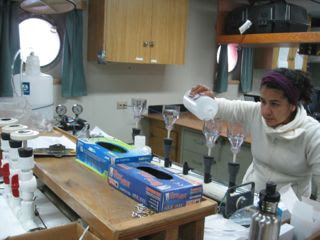 |
| Figure 1. Deploying the CTD and Niskin bottles in order to study what exactly is in this seawater the ship is sailing through. |
One aspect of the water we are interested in is its physical properties (such as its temperature, salinity and density). We study these properties with an instrument called a CTD (Conductivity Temperature Depth sensor). Both temperature and salinity (i.e. the salt content of the water) affect the water’s density. In most parts of the world’s ocean, temperature is the most important factor controlling the density of the water. However, the Southern Ocean is different. Here, the temperature doesn’t change much…its cold…often. The salinity, however, changes much more because of the melting of the seasonal sea ice. Therefore, the changes in how much freshwater is melting into the ocean from the ice change the density of the water here much more than the small seasonal changes in temperature.
Another thing we study when looking at the water is its biological and chemical properties. In order to do this, we collect water from bottles (called Niskin bottles, named after Shale Niskin, who patented the bottle design in
Both the Warren and Bucklin science teams on our cruise are filtering water for clues about the environment here. I’ll hand this over now to Paola to talk about what her group is interested in finding out about the seawater.
In our hunt for salps, we are trying to understand their distribution patterns and the chemistry of the ocean holds lots of clues as to where we might find these gelatinous critters! The Bucklin lab is looking at both the nutrients and particulates in the seawater.
In the area of Antarctic waters where we are working, concentrations of nutrients (nitrate and phosphate) are much higher than those found in other oceanic waters. They tend to be lowest at the surface and greatest in the warm deep waters.
Particulates, alternatively referred to as particulate organic matter (POM), are tiny particles of solid material present in the water column. Particulates within the water column come in a multiplicity of sizes and from a great variety of sources: dead phytoplankton cells, fragments from attached macroalgae, dead bacteria, dead protozoa, dead micro- and macro-zooplankton, crustacean exuvia, and fecal pellets, especially those from copepods, euphausiids, and salps.
 |
| Figure 4. Paola concentrating on filtering the seawater for nutrients and particulates. |
So, if we want to look at the big picture and understand the behavior or occurrence of salps in the Southern Ocean, the characterization of the chlorophyll by the Warren team will help with understanding the prey (phytoplankton) distribution. The Bucklin side of the analysis will help with understanding under what nutrient and particulate concentrations we tend to find salps more frequently.
Well, that’s it for today’s lesson: “What’s in Seawater?” Hope you learned something!
-- Paola Batta-Lona (University of Connecticut)


No comments:
Post a Comment